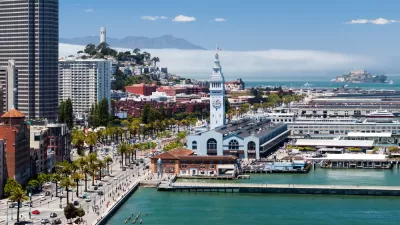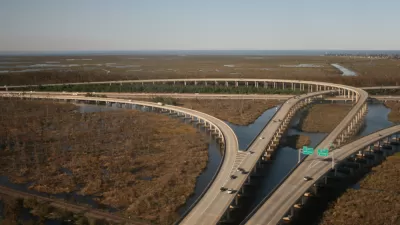A bombshell report details the adaptation measures that will be necessary to keep San Francisco's Embarcadero high and dry as the climate changes and sea levels rise.

John King reports on the reality of sea-level rise in San Francisco in a paywalled article for the San Francisco Chronicle:
San Francisco will need to elevate portions of the Embarcadero as much as 7 feet in coming decades to prepare itself for rising bay waters, according to a shoreline defense strategy taking shape at the Port of San Francisco.
King adds:
The early projects, which are forecast to take roughly a decade to design and complete, would focus on spots that are particularly vulnerable to earthquakes, as emphasized by the 2018 bond. The report doesn’t preview any of the projects to be proposed next month, but a hazards assessment by the port last year found that large portions of the seawall north of the Bay Bridge are at “high risk” in a major temblor.
More details on the Embarcadero Seawall Program, a component of the Port of San Francisco's larger Waterfront Resilience Program, is available online.
For non-paywalled news on the most recent report and its proposal for a seven-foot increase in the height of the Embarcadero, see also coverage by Melissa Colorado for NBC Bay Area and an aggregated version of King's article by Joe Kukura for SFist.
FULL STORY: S.F.'s Embarcadero needs to be raised as much as 7 feet to prepare for sea level rise, city says

Alabama: Trump Terminates Settlements for Black Communities Harmed By Raw Sewage
Trump deemed the landmark civil rights agreement “illegal DEI and environmental justice policy.”

Planetizen Federal Action Tracker
A weekly monitor of how Trump’s orders and actions are impacting planners and planning in America.

The 120 Year Old Tiny Home Villages That Sheltered San Francisco’s Earthquake Refugees
More than a century ago, San Francisco mobilized to house thousands of residents displaced by the 1906 earthquake. Could their strategy offer a model for the present?

In Both Crashes and Crime, Public Transportation is Far Safer than Driving
Contrary to popular assumptions, public transportation has far lower crash and crime rates than automobile travel. For safer communities, improve and encourage transit travel.

Report: Zoning Reforms Should Complement Nashville’s Ambitious Transit Plan
Without reform, restrictive zoning codes will limit the impact of the city’s planned transit expansion and could exclude some of the residents who depend on transit the most.

Judge Orders Release of Frozen IRA, IIJA Funding
The decision is a victory for environmental groups who charged that freezing funds for critical infrastructure and disaster response programs caused “real and irreparable harm” to communities.
Urban Design for Planners 1: Software Tools
This six-course series explores essential urban design concepts using open source software and equips planners with the tools they need to participate fully in the urban design process.
Planning for Universal Design
Learn the tools for implementing Universal Design in planning regulations.
Clanton & Associates, Inc.
Jessamine County Fiscal Court
Institute for Housing and Urban Development Studies (IHS)
City of Grandview
Harvard GSD Executive Education
Toledo-Lucas County Plan Commissions
Salt Lake City
NYU Wagner Graduate School of Public Service





























